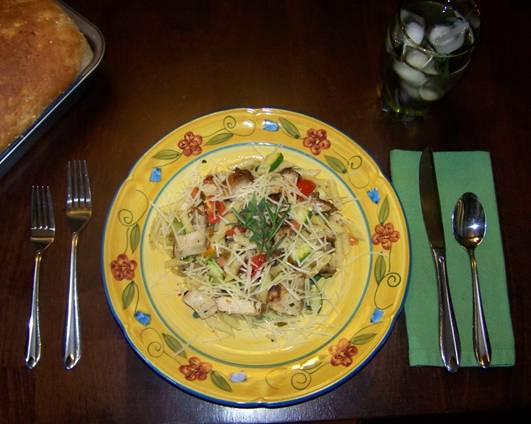Garlic and Garlic Scape Recipes
“Tomatoes and oregano make it Italian;
Wine and tarragon make it French.
Sour cream makes it Russian;
Lemon and cinnamon make it Greek.
Soy sauce makes it Chinese;
Garlic makes it good.”
~Alice May Brock
Available in June, garlic scapes are the flower stalk of the garlic. We are taking garlic scapes orders right now! The entire stalk and flower are edible. With mild garlic flavor and aroma, they are wonderful additions to stew, roasts, marinade, salads, sandwiches, sauces, bread, pasta, pesto, stir-fry, roasted, or even steamed and eaten as a vegetable. The possibilities are endless!
We have tried many of the following recipes using garlic cloves or scapes (and many more!), although a few use scapes specifically for their size and color. If you don’t have scapes, use a few cloves of garlic and see how it goes!
Oh, and before you cook with garlic next time, check out this video to learn “How to peel garlic in 10 seconds” because it does work!
More to come! Feel free to send your recipe for inclusion here…



Scapes can be frozen whole, or diced and bagged for freezing!
Simply wash, mince (you can even use the tip (flower), or can cut it off if desired), bag, and freeze.

Breads Pastas Dips/Sauces/Dressings Just Scapes Miscellaneous Uses

BREADS
Garlic Monkey Bread
Mix the dough in a bread machine for ease, or try tubes of biscuit dough from the grocery store instead of homemade bread. I’ve not used the biscuit tubes, but they work for cinnamon Monkey Bread, and might work if you aren’t a homemade bread baker.
1 cup milk
1 egg
1/2 cup mozzarella cheese
3/4 cup whole wheat flour
2 1/4 cups bread flour
4 tsp sugar
4 tsp fresh oregano, OR 1 1/2 tsp dried oregano
3/4 tsp salt
1 tsp active dry yeast
Add ingredients to bread machine and set on dough cycle. When finished, place dough on lightly floured surface and pat to 1/2+ inch thickness. Cut dough into about 32 pieces.
Garlic Butter Mixture:
1/4 cup butter or margarine, melted
Diced garlic or chopped garlic scapes to taste (we like a LOT of garlic flavor!)
Dip dough chunks into the garlic/scape mixture and place them butter-side down in a greased bundt pan. Continue dipping and layering dough with butter side down until all dough is in the bundt pan.
Bake at 375 until brown (15 to 25 minutes, depending upon the size of the cake pan). Invert onto a serving dish and serve warm…maybe with some additional garlic butter to dip the pieces in!

Veggie and Chicken Pizza with Scapes

Pizza crust (I used half of a bread recipe and added garlic and diced scapes to the dough)
1 block cream cheese, softened
1/3rd bottle of Ranch salad dressing
Veggies of choice (asparagus, spinach, broccoli, red peppers, zucchini, etc.), sautéed or cooked
Bleu cheese crumbles, optional
Cooked shredded or diced chicken, optional
Garlic scapes (minced, whole, or chopped)
Make crust and partially bake. Poke holes with a fork around the crust, except for the outer 1″ edge.
Mix the veggies with the cream cheese and Ranch dressing. Salt/Pepper to taste. Spread on crust.
Top with chicken, bleu cheese, and scapes, then mozzarella cheese.
Bake at 350 degrees until the cheese bubbles and it’s hot!

PASTAS
Summertime Herbed Chicken and Pasta
An easy, colorful, and healthy main dish using fresh herbs, and vegetables…perhaps from your own garden.
Ingredients:
2 cups cooked diced boneless chicken breast – grilled or baked
2 cups Penne Pasta or Mini Penne Pasta
¼ cup extra virgin olive oil
1 cup zucchini – diced
½ cup red or orange pepper – diced
¼ cup carrots – thinly sliced
¼ cup garlic scapes – chopped – optional
¼ cup onion – slivered or diced
½ cup quartered cherry tomatoes
4-5 large garlic cloves* – chopped or pressed (or you could go for it and use the entire bulb!)
2 Tbls fresh basil* – finely chopped
1 tsp fresh oregano* – finely chopped – optional
1 tsp fresh thyme* – finely chopped – optional
½ tsp fresh rosemary* – finely chopped – optional
Grated Parmesan and/or Romano Cheese
Cracked pepper
Salt
Rosemary or oregano sprigs – optional
Prepare pasta as directed, drain, return to pan, and cover.
While pasta is cooking, heat diced chicken breast in approx 2 tablespoons of olive oil in a skillet.
Remove chicken, set it aside, and cover.
Add approx 2 tablespoons of olive oil to skillet and turn heat to medium-high.
Saute onion, peppers, carrots, scapes, and garlic until slightly tender.
Add fresh herbs*
Combine chicken, vegetable mixture, and pasta.
Add remaining olive oil.
Heat through.
Salt and pepper to taste.
Place in serving the dish. Top with freshly cracked pepper and grated cheese. Garnish with rosemary or oregano sprigs.
Serve with homemade garlic bread topped with garlic scape butter.
Serves a hungry family of 4
*You can use store-bought pesto in place of the fresh herbs. Substitute approximately 3 heaping tablespoons of pesto for herbs. More or less subject to taste.
Garlic Scape Carbonara
serves 4
This pasta is fantastic as a meal served with a big garden salad and some crusty bread. If desired, add a half-cup of fresh, lightly cooked peas to the mix for a little added nutrition (and sweetness).
1/2 lb Campanella pasta, or shape of your choosing
4 slices bacon (about 3 1/4 ounces), chopped
1/4 cup garlic scapes, cut into 1/4 inch coins
2 large eggs
1/4 tsp kosher salt
1/4 tsp red pepper flakes
1/2 cup freshly grated Romano cheese
Set a pot of water to boiling on the stove and cook the Campanella pasta (or desired shape).
While it’s cooking, cook the bacon over medium heat until browned. Remove the bacon pieces with a slotted spoon and add the garlic scapes. Cook until soft (2-3 minutes). Remove from the pan with a slotted spoon. (Drain both the bacon and the garlic scapes on a paper towel).
Whisk together the eggs, salt, and red pepper flakes.
When the pasta is done, quickly remove it from the stove and set a different burner to low heat. Drain the pasta and add it back to the pot, on the burner set to low. Stir in the garlic scapes and bacon. Add the egg mixture and stir feverishly for 3-4 minutes until sauce is thick and creamy. Don’t let it overcook or it will be gloppy. Sprinkle the Romano cheese in, a little at a time, and stir to combine. Don’t add it all at once or it won’t mix throughout the pasta as well (since it will clump).
Serve immediately. http://sarahscucinabella.com/

DIPS, SAUCES, DRESSINGS
Garlic Scape Pesto
1 pound garlic scapes
1 cup grated parmesan cheese
Olive oil (about 1/2 to 1 cup)
2 Tbls lemon juice (optional)
½ cup Walnuts (optional)
Chop the garlic scapes into 3-inch lengths. Put it in the food processor and process until pureed. Add the parmesan and walnuts and process until smooth. Add lemon juice then slowly add the olive oil as the food processor runs and continue until all the oil is combined into the garlic. Store in an air-tight jar in the refrigerator for up to 2 weeks or freeze.
Pesto is wonderful on bread, sandwiches, pasta, focaccia, or on meat such as chicken and fish.
Additional resources:
- A Nut-Free Garlic Scape Pesto at Kalyn’s Kitchen

White Bean and Garlic Scape Dip
1/3 cup sliced garlic scapes (3 to 4)
1 tablespoon freshly squeezed lemon juice, more to taste
1/2 teaspoon coarse sea salt, more to taste
Ground black pepper to taste
1 can (15 ounces) cannellini beans, rinsed and drained
1/4 cup extra virgin olive oil, more for drizzling.
In a food processor, process garlic scapes with lemon juice, salt, and pepper until finely chopped. Add cannellini beans and process to a rough purée.
With motor running, slowly drizzle olive oil through feed tube and process until fairly smooth. Pulse in 2 or 3 tablespoons water, or more, until mixture is the consistency of a dip. Add more salt, pepper and/or lemon juice, if desired.
Spread out dip on a plate, drizzle with olive oil, and sprinkle with more salt. Serve with bread, tortilla chips, etc.

Simple Garlic Vinaigrette
1 cup of vegetable oil
1/3 cup apple cider vinegar (or be creative…try red wine vinegar or white vinegar)
3 tablespoons honey
2 small to medium-sized cloves garlic (or one large clove), minced
Optional: sea salt, pepper, dill to taste
In a container, combine oil, vinegar, honey, and garlic. Cover, and shake until blended. Set aside for 45 minutes, to allow flavors to combine. Shake again before serving.
Once the vinaigrette is a couple of weeks old, it should no longer be used on salad. Pour the left-over vinaigrette over chicken breasts and marinate all day. Bake in a casserole dish for extremely moist, tender, and tasty chicken!

Emeril’s Roasted Garlic Vinaigrette
2 large heads of garlic
Olive oil, for drizzling
¼ teaspoon salt, plus more for seasoning
¼ cup red wine or balsamic vinegar
1 tablespoon chopped parsley
1 ½ teaspoon honey
½ cup olive oil or leftover tuna poaching oil
1/8 teaspoon ground black pepper
Preheat the oven to 350 degrees. Cut about 1/2-inch off the top of the garlic heads. Place on a sheet of foil and drizzle with a bit of olive oil and season with salt. Wrap the foil into an “envelope” and place on a baking sheet. Transfer to the oven and cook until soft, about 1 hour. Remove from the oven and set aside to cool and then peel.
Combine the garlic, vinegar, parsley, and honey in a blender and puree until smooth. With the motor running, slowly add the oil in a steady stream until emulsified. Season with the ¼ teaspoon salt and pepper. Alternately, combine the ingredients in a medium-sized mixing bowl and whisk until emulsified.
Yield: ¾ cup.

Monty’s Secret Garlic White Sauce
1 Cup Canola
4-5 crushed garlic cloves
1 Tsp salt or less
Juice from 1/3 of a lemon
1-2 egg whites
With a hand blender blend the first 4 ingredients for 1.5 minutes, use a tall-sided container so it does not splatter. Add 1 egg white and blend for 20 seconds add the second egg white if it does not solidify. It should be the thickness of margarine.
Serve with meat or use as a sandwich spread.
Additional similar recipes and more information:
Garlic Sauce Recipe and Instructions Includes an egg-free version
Toum (Lebanese Garlic Sauce) Detailed instructions about how to get the best texture/consistency for your sauce/spread

JUST SCAPES
Sautéed Garlic Scapes

2 tbsp olive oil
2 tbsp dark brown sugar
8 oz garlic scapes, trimmed
1 1/2 cups coarsely chopped tomatoes
3/4 cup dry white wine
1/4 tsp ground pepper
1 tsp salt
1 tbsp chopped parsley
1/4 cup grilled halloumi cheese, diced
Heat the oil in a sauté pan and add sugar. Stir to caramelize the sugar for about 2-3 minutes and add the scapes. Cover and sauté over medium-high heat for no more than 3 minutes, occasionally shaking the pan to prevent scorching. After 3 minutes, add the tomatoes and wine. Stir, then cover and reduce heat to low; continue cooking 5-6 minutes or until scapes are tender but not soft. Season, then add the parsley and halloumi. Serve warm or at room temperature.
Haloumi Cheese Note: Haloumi cheese is a goat and/or sheep cheese made in Cyprus. It can be sliced and grilled or fried in a skillet, and it doesn’t melt. Other salty cheeses such as cheddar or aged chevre can be substituted.

Grilled Garlic Scapes
Grilled scapes are sweet with a mild garlic/onion flavor. Even our children love them!
Wrap scapes in tinfoil with a little bit of olive oil. Some people just lay tinfoil on the grill, add oil, and grill uncovered.
Grill until tender.
Salt if desired, and enjoy!

MISCELLANEOUS USES OF GARLIC AND SCAPES
Homemade Garlic Powder
The garlic powder you buy in the store may contain dehydrated and bleached shucks, stems, etc. so the actual amount of true garlic in store-bought garlic powder may be minimal. Homemade garlic powder is so superior…a must-have item in our kitchens!
Shuck the garlic and peel cloves. (Polish White makes a nice, fine-textured powder, and German Red is full-bodied)
Mince in a food processor
Dehydrate the minced garlic (don’t dehydrate whole cloves unless you have a very strong food processor, as they become too hard to powder if left whole)
Process again after dehydrating until the correct consistency of powder is reached.
Store in an airtight container, and enjoy!
Pickled Garlic Scapes
1 pound or more of scapes, whole
3 cups vinegar
5 cups of water
¼ cup kosher salt
Fresh Basil Leaves
Chili Flakes
Boil the water, vinegar & salt solution. Pack hot jars with whole scapes, 1 fresh basil leaf, a pinch of chili flakes (depending on your spice tolerance) and then the brine. Put on lids, place in a hot water canner and boil for 45 minutes. Leave at least 2 weeks before serving to get the best flavor.

Garlic Scape Soup
From Super Natural Cooking, by Heidi Swanson
2 tablespoons clarified butter or extra-virgin olive oil
2 dozen garlic scapes, flower buds discarded and green shoots chopped
3 large russet potatoes, unpeeled and cut into ½ inch dice
5 cups vegetable stock or water
2 large handfuls spinach leaves, stemmed
Juice of ½ lemon
½ teaspoon fine-grain sea salt
Freshly ground black pepper
¼ cup heavy cream (optional)
Chive blossoms, for garnish (optional)
Heat the butter in a large saucepan over medium heat, then add the scapes and sauté for 2 minutes.
Add the potatoes and stock, cover, and simmer for about 20 minutes, or until the potatoes are cooked through and beginning to break down.
Remove from the heat, add the spinach, and puree using a hand blender. (If you must use a conventional blender, be careful; the hot liquid can burst out the top and make a huge, potentially painful mess. Try leaving the lid slightly ajar to allow steam to escape. Cover the top with a kitchen towel and blend in batches at low speed.)
Season with the lemon juice, salt, and a few grinds of pepper.
Whisk in the cream for a silkier texture.
If the soup tastes flat, add salt a few big pinches at a time until the flavors really pop.
Serve garnished with the chive blossoms.
Serves 4 to 6.

Garlic Marinade
From Two Creek Farms Botanical Sanctuary
I use jelly jars and about 4 bulbs separated and peeled; use 1 third cup Tamari sauce, 1 third honey, and 1 third water; let it stay in the fridge for a month at least. I use the marinade to stir fry when the garlic is gone, and I like to bake chicken with the cloves, as they get caramelized. You can use larger jars for your own use but the jelly jars make nice gifts. Enjoy!

OTHER IDEAS:
- A simple but wonderful garlic scape spread or dip can be made by chopping some scapes up and mixing them with softened cream cheese (or sour cream) and dill. (eHow.com)
- You can add garlic scapes to mayonnaise to make aioli. When combined with mayonnaise, the flavor of chopped garlic scapes becomes milder and the savory notes are more apparent. (eHow.com)
- You can also make a nice garlic scape dressing in sour cream to add to salads, use as a dip for crackers, toast points, and pork rinds or to spoon over a nice salad. (eHow.com)
- You can also chop up garlic scapes and use them for seasoning, just like regular garlic. (eHow.com)
- http://www.starchefs.com/features/garlic_scapes/html/index.shtml
- Octopus with Fingerlings and Garlic Scapes at Foodista
- Grilled Garlic Scapes at FoodieTots
- Pickled Dilly Garlic Scapes at Becky and the Beanstock
- Chop scapes in one-inch pieces, sauté in brown butter and add fresh sweet corn.
- Use as you would asparagus. I bet you saw that coming.
- Add to an omelet or a frittata, a.k.a. the ultimate refrigerator velcro.
- Makes salads and pasta a bit more interesting. It has a “secret ingredient” potential.
- Grill, roast, or broil with olive oil and salt.
- Garlic scapes sautéed in butter are excellent with mashed or lightly browned diced potatoes for a quick side dish.
- Creamy garlic scape soup
- Korean recipe for pickled whole garlic
- Puree with your favorite dips to give it a subtle garlicky punch and a cool shade of green.
- Stir-fry with rice, noodles, vegetables, or meats.
- Deep-fried with a light tempura-like batter
- Add finely chopped garlic scapes to bread dough.










